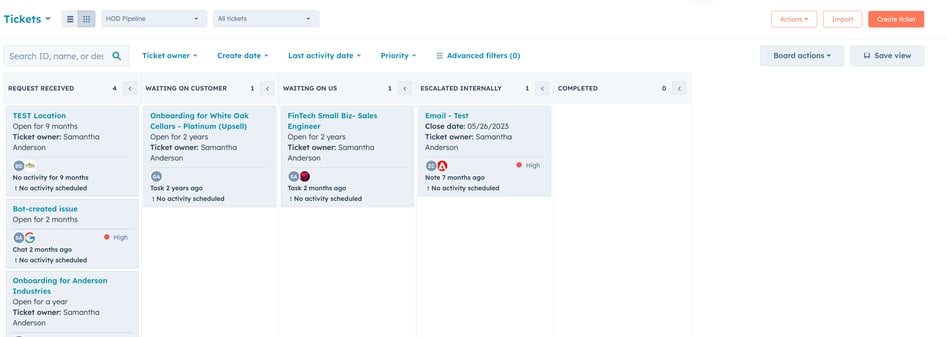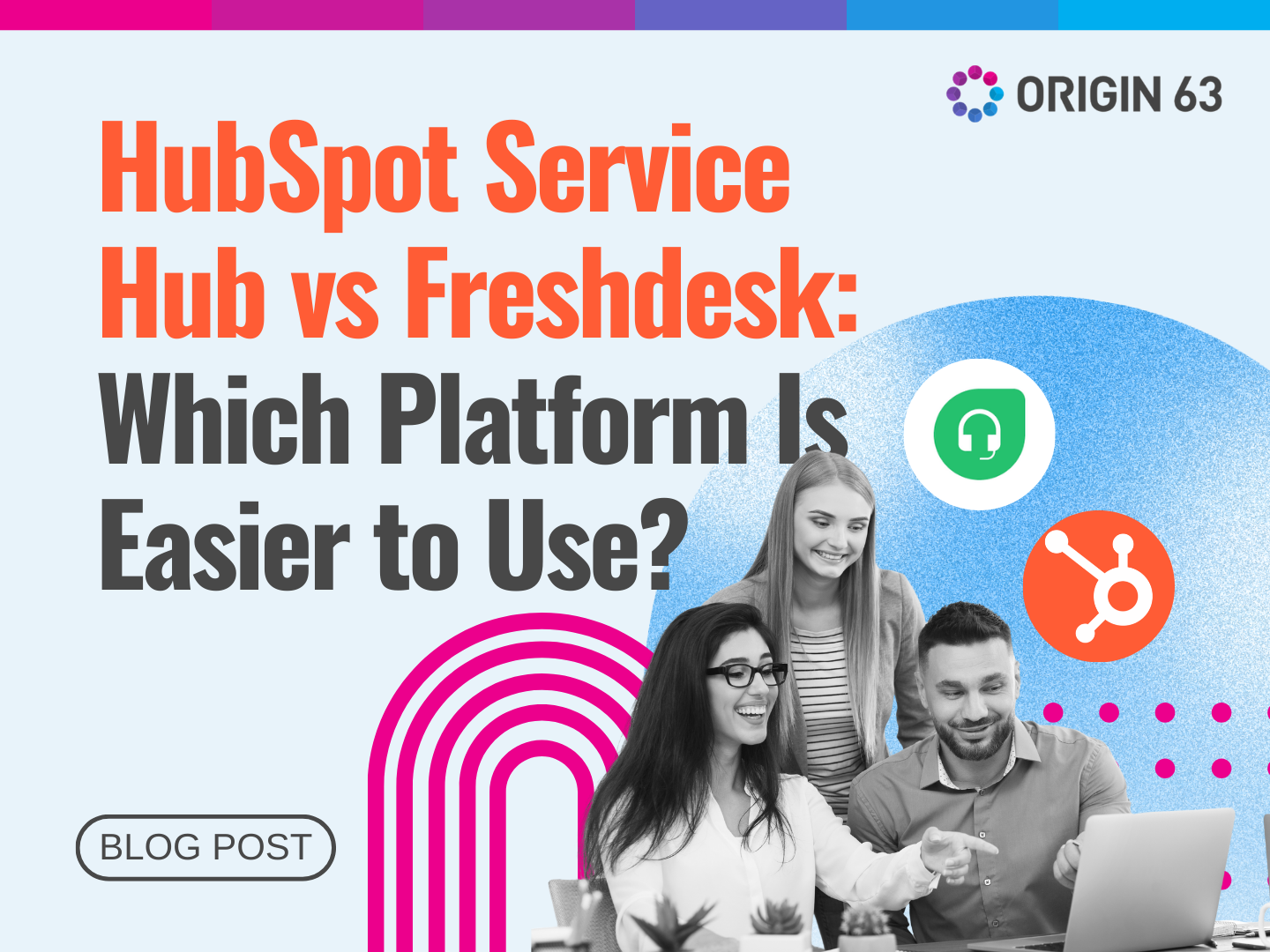Delivering satisfying customer experiences starts with effective systems. When support teams deal with disjointed processes and lost tickets, your customers are frustrated, and you’re overwhelmed.
Then what? You get bad reviews, damage your reputation, or increase churn rates. Before it happens, optimize your ticketing system to scale and streamline service operations.
We’ll help you learn everything you need about ticketing— including basics, choosing the right system, and implementing efficient ticketing processes to maximize results.
What’s Ticketing in Customer Service?
Ticketing is the system customer support teams use to track, prioritize, and manage customer queries and issues.
It typically involves creating a “ticket” containing customer information, details about the problem or request, and any communications or updates related to resolving it.
Good ticketing systems consolidate customer interactions across channels like email, live chat, and self-service portals into a central place. It gives agents the full context needed to deliver personalized support.
The Importance of Efficient Ticketing for Customer Satisfaction
How you handle issues affects customer satisfaction. 67% of consumers say correctly resolving issues is the most important part of online transactions.
When ticketing is organized and efficient, your teams can quickly track and resolve customer issues with fewer problems, leading to happier customers.
Here are some more benefits of an efficient ticketing system:
- No queries fall through the cracks, so all issues are resolved
- Support teams can prioritize and address the most urgent customer needs first
- You have a single unified platform to collaborate and manage the lifecycle of issues
- Analytics to improve response times and satisfaction
- Agents have the insight needed to deliver personalized, contextual support
Conversely, fragmented ticketing processes lead to frustration, delays, and duplicated efforts — severely impacting customer satisfaction.
How Ticketing Systems Streamline Customer Service
Ticketing systems are the central hubs for agent-customer communication. The right platform makes it easy to manage all customer issues efficiently at scale.
Here are some capabilities you’ll want to look for:
- Omnichannel support: email, self-service, social media, chat, and call channels.
- Automated ticketing and routing based on rules
- Service-Level Agreements (SLAs) and priority assignment
- Knowledge base integration
- Customizable workflows
- Reporting and analytics on ticket data
- Integrations with other systems like CRM
- Simple, intuitive interface for agents
Customer Service Ticketing Basics
Before choosing and implementing a ticketing software, let’s go back to the basics. Let’s define customer service tickets and walk through their lifecycle stages.
What Is a Customer Service Ticket?
A customer service ticket is a record containing the details of a customer's inquiry, issue, or request that requires support or resolution. Tickets are the building blocks of customer service tracking.
You’ll usually find some of this information in a support ticket:
- Customer info like name, contact details, account info
- Issue description, questions, comments from the customer
- Support agent assignments and internal communications
- Status, priority level, and service level agreement (SLA)
- Related correspondence, documentation, conversation history
- Resolution steps taken and final outcome
Here’s a support ticket example on HubSpot Service Hub’s Ticket View:
The Lifecycle of a Customer Service Ticket
Customer support tickets go through several stages from initial creation to resolution. The exact stages can change depending on your ticketing system. Some platforms, like Service Hub’s Tickets and Tasks, let you customize the stages.
But in most cases, the ticket lifecycle looks like this:
1. A ticket starts in "New" status when a customer submits a new request. For now, it hasn't been assigned to an agent yet.
2. Once an agent claims it, they’ll switch it to "Open," so others know someone’s working on it.
3. If the agent needs more info from the customer to solve the issue, they'll change the status to "Pending" while they wait for a response.
4. Sometimes, the agent has to hold off handling the ticket until they get additional details from another team or external party. Then, they’ll set it to "On-Hold" until they have what they need.
5. After the agent resolves the customer's issue, they'll mark the ticket as "Solved." If the customer replies with follow-up comments, the agent can reopen it.
6. Finally, if a solved ticket goes a certain period without the customer responding or needing anything else, it will automatically switch to "Closed."
Here’s how a customer service agent may view tickets according to their stage in HubSpot Service Hub:

Choosing the Right Ticketing System
You should carefully choose the best ticketing platform for your company to streamline customer service operations successfully.
Let's explore how to evaluate options and choose a system tailored to your needs.
Step 1: Understand Your Customer Service Needs
The first step is analyzing your current customer service processes. What are areas you should improve?
Interview your customer service agents and review metrics like ticket volume, resolution times, and satisfaction scores.
In your investigation, note the emerging pain points, inefficiencies, and desired outcomes. Then, brainstorm which features and capabilities would address those problem areas.
Here are some examples of translating pain points into required capabilities when evaluating a ticketing system:
- If wait times for initial ticket responses are too high, prioritize automation for instant acknowledgment and routing.
- If reporting lacks insights, focus on advanced analytics for trend analysis.
- If customers must repeat info, knowledge base integration and previous thread visibility will help agents.
Step 2: Evaluate Features and Capabilities of Ticketing Systems
After identifying your needs, create a checklist of required features, including omnichannel support, SLAs, reporting, integrations, etc. Research platforms and compare capabilities to your list.
Narrow down systems that meet critical requirements.
For example, here’s a brief comparison of HubSpot and Zendesk.
|
Features |
Zendesk |
HubSpot |
|
Ticketing System |
Robust ticketing system with macros and custom layouts |
Intuitive ticketing with collaboration capabilities and user-friendly interface |
|
Knowledge Base |
Multiple knowledge bases, community forums |
Unified knowledge base integrated with website Content Management System (CMS) |
|
Self-Service |
Help Center with community forums |
Customer portal, chatbots, and knowledge base with multilingual support |
|
Integrations |
Around 250 integrations |
500+ integrations |
|
CRM Capabilities |
None, no native CRM |
Native CRM provides 360-degree customer view and alignment between sales, marketing, and service |
|
Automation |
Light workflow automation |
Advanced automation for workflows, ticket assignment rules, notifications, escalations, etc. |
|
Analytics |
Good analytics and reporting |
Customizable dashboards, advanced analytics |
|
AI Capabilities |
Limited AI functionality |
Chatbots, intelligent content recommendations, and other growing AI capabilities. |
HubSpot has an edge over Zendesk on a few points. Most notably, it has native CRM capabilities and robust workflow automation. It can also connect sales, marketing, and service on one interface for a 360-degree customer view, letting you deliver personalized support.
So, someone who needs tools that provide a complete view of their customers and maximize efficiency for their support team may lean towards HubSpot.
Step 3: Select a System that Integrates with Your Business Operations
After analyzing your service needs and comparing capabilities across different platforms, it's time to evaluate ticketing systems holistically to make a final decision.
You should look beyond customer service functionality. Selecting a platform that integrates smoothly across your entire customer operations avoids silos. Carefully consider how seamlessly a ticketing system connects with other teams like sales and marketing.
Prioritize unified solutions like HubSpot Service Hub that interoperate natively with CRM, marketing automation, email, and other systems. This connectivity empowers teams to collaborate and deliver personalized cross-channel experiences.
Choose Hubspot and Work with Us to Transform Your Customer Service!
Implementing an Efficient Ticketing Process
Once you've selected a ticketing system, the next step is optimizing your ticketing processes. Now, you can see why you need features like automation and omnichannel support in your ticketing system.
These three simple strategies let you leverage those features to streamline customer service:
Design a Clear Ticket Submission Process for Customers
Make it easy for customers to submit tickets through preferred channels like email, web forms, and call-ins. Provide clear guidance on information required, hours of support, and expected response times.
Automate Quick Ticket Assignment and Triage:
Use rules to route tickets automatically to the appropriate agents or teams based on criteria like issue type, account tier, and product. Automation enables instant and accurate assignment.
Set Priority Levels for Effective Resource Allocation
Categorize tickets based on urgency and impact, such as high, medium, and low priority. Ensure SLA compliance by addressing high-priority issues first. Make it easy for agents to identify and tackle critical tickets.
With an optimized process, your team can work through customer issues swiftly. Continuously refine workflows and policies to enhance efficiency at scale.
Communication and Collaboration Through Ticketing
Ticketing systems don't just track issues — they let you and your team communicate and collaborate seamlessly to resolve customer inquiries.
Here are three ways ticketing improves communication and collaboration:
Internal Communication Among Customer Service Teams
With tickets, you get a shared platform for agents to communicate about complex issues requiring collaboration. Comments, @mentions, and assignments keep your teams aligned.
In Service Hub, for example, agents can quickly pass a ticket to a different team through @mentions within the ticket.
Updating Customers on Ticket Status and Resolutions
Tickets let agents give ongoing status updates to customers throughout the resolution process. When customers know you’re in the process of resolving their issues, they’re less impatient. It improves their overall experience.
Integrating Ticketing with Other Communication Channels
Leading ticketing platforms integrate with channels like email, live chat, and social media messaging so that agents can communicate with customers directly from within tickets. This feature keeps conversations connected to issues.
With robust communication capabilities baked into ticketing, teams can deliver unified, contextual service across channels while keeping customers in the loop.
Conclusion
Delivering streamlined customer service is the first step to creating positive customer experiences. An efficient ticketing system consolidates interactions, automates routing, provides collaboration capabilities, and enables data-driven improvements.
By choosing customer service software like HubSpot that aligns capabilities with your specific needs, you empower your agents to deliver streamlined support experiences.
The right solution powers efficient processes so your team can drive customer satisfaction, loyalty, and growth.
Explore and Implement a Ticketing System to Enhance Your Customer Service Operations
HubSpot Service Hub provides a complete, connected ticketing platform that seamlessly integrates with a unified CRM. Advanced customization, automation, reporting, and omnichannel support enable streamlined workflows and unified customer experiences.
Work with the experts at Origin 63 to implement HubSpot Service Hub and transform your customer service. Our team can ensure smooth onboarding, optimal configuration tailored to your needs, enhanced processes, and user adoption success.
Contact Origin 63 to discuss how HubSpot Service Hub can help your company deliver efficient, satisfying support!













.png?width=90&height=90&name=Arrows%20Partner%20Badge-test%20(1).png)

